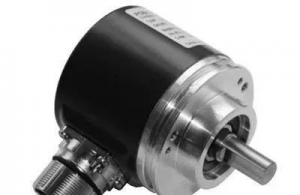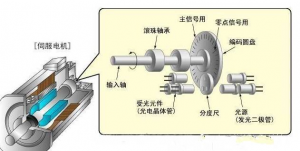During the operation of the motor, real-time monitoring of parameters such as current, rotational speed, and the relative position of the rotating shaft in the circumferential direction can determine the status of the motor body and the device being dragged, and further control the operating status of the motor and equipment in real-time, thereby realizing many specific functions such as servo and speed regulation. Here, using the encoder as the front-end measurement component not only greatly simplifies the measurement system, but also is precise, reliable, and powerful. The encoder is a rotary sensor that converts the position and displacement of the rotating part into a series of digital pulse signals. These pulse signals are collected and processed by the control system, and a series of instructions are issued to adjust and change the operating status of the equipment. If the encoder is combined with a gear rack or a screw, it can also be used to measure the position and displacement of linear motion components.
An encoder is a precision measuring device that combines machinery and electronics closely and encodes and converts signals or data for communication, transmission, and storage of signal data. According to different characteristics, the classification of encoders is as follows:

Commonly used encoders for motors
Directly use the principle of photoelectric conversion to output three groups of square wave pulse A, B, and Z phases. The phase difference between A and B two groups of pulses is 90°, which can easily determine the direction of rotation; the Z phase has one pulse per revolution, which is used for reference point positioning. Its advantages: simple principle and structure, average mechanical life of more than tens of thousands of hours, strong anti-interference ability, high reliability, suitable for long-distance transmission. Disadvantage: It is impossible to output the absolute position information of the shaft rotation.
A sensor that directly outputs digital quantities. There are several concentric code tracks in the radial direction on the circular code disc of the sensor. Each track is composed of light-transmitting and opaque sectors alternately. The number of sectors in adjacent code tracks is double. , the number of code channels on the code disc is the number of its binary digits. On one side of the code disc is a light source, and on the other side there is a photosensitive element corresponding to each code channel; when the code disc is in different positions, each photosensitive element Whether it is illuminated or not, the corresponding level signal is converted to form a binary number.
The feature of this encoder is that it does not need a counter, and a fixed digital code corresponding to the position can be read at any position of the rotating shaft. Obviously, the more code tracks, the higher the resolution. For an encoder with N-bit binary resolution, its code disc must have N code tracks. At present, there are 16-bit absolute encoder products in China.
It consists of a photoelectric code disc with a shaft in the center, on which there are ring-shaped and dark engraved lines, which are read by photoelectric emitting and receiving devices, and four groups of sine wave signals are obtained and combined into A, B, C, D. Each sine wave With a phase difference of 90 degrees (360 degrees relative to one cycle), the C and D signals are reversed and superimposed on the A and B phases to enhance the stable signal; in addition, a Z-phase pulse is output per revolution to represent the zero reference bit.
Encoders play an extremely important role in elevators, machine tools, material processing, motor feedback systems, and measurement and control equipment. The encoder uses a grating and an infrared light source to convert the optical signal into a TTL (HTL) electrical signal through the receiver and intuitively reflects the rotation angle and rotation position of the motor through the analysis of the TTL level frequency and the number of high levels.
Since the angle and position can be measured accurately, the encoder and frequency converter can be used to form a closed-loop control system to make the control more precise. This is why elevators and machine tools can be used so accurately.
5. Summary
To sum up, we understand that encoders are divided into incremental and absolute types according to their structure. They also convert other signals, such as optical signals, into electrical signals that can be analyzed and controlled. The elevators and machine tools that are common in our life are just based on the precise adjustment of the motor. Through the feedback closed-loop control of the electrical signal, the encoder cooperates with the frequency converter to achieve precise control as a matter of course.

Encoder structure
Since the difference between A and B phases is 90 degrees, the forward and reverse rotation of the encoder can be judged by comparing whether the A phase is in front or the B phase is in front, and the zero reference position of the encoder can be obtained through the zero pulse. Encoder code discs are made of glass, metal, and plastic. Glass code discs have thin engraved lines deposited on glass. They have good thermal stability and high precision. Metal code discs are directly engraved with pass and no pass, and are not easy to break. However, since the metal has a certain thickness, the accuracy is limited, and its thermal stability is an order of magnitude worse than that of glass. Plastic code discs are economical, and their cost is low, but their accuracy, thermal stability, and service life are all worse.
Resolution—The number of open or dark engraved lines provided by the encoder per rotation of 360 degrees is called the resolution, also known as resolution division, or how many lines are directly weighed, generally 5 to 10,000 lines per revolution.